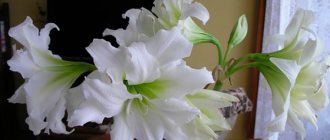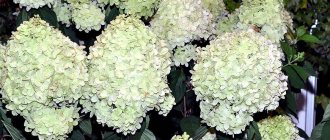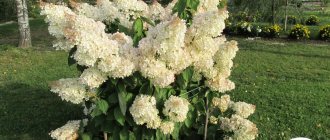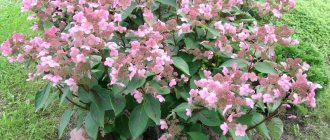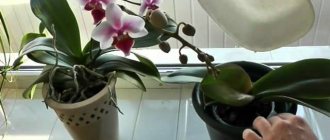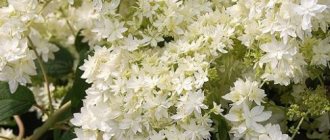Hydrangeas have firmly entered gardens and parks as long-flowering shrubs. The flowering time of each garden hydrangea bush depends on the variety, pruning method, and weather conditions.
Breeding research in the field of breeding new decorative flowering hydrangea varieties has been going on for about a hundred years. This explains such a wide variety of garden hydrangea varieties. Initially, lush flowering was observed only for two or three summer months. Gradually this period expanded to three to four months. Although, there are varieties that bloom only for one and a half to two months.
Short-flowering hydrangeas differ from most varieties in their unusual decorative features.
What year does hydrangea bloom after planting?
Hydrangea is a spectacular and bright flower that pleases the eye with its lush inflorescences and riot of colors.
It has long won the sympathy of flower growers and began to be planted in the garden and at home, as a houseplant. The culture is not considered whimsical and does not require special growing conditions. But sometimes the question arises, what year does hydrangea bloom after planting, since often the flowering dates differ significantly. Hydrangea is a tree or bush plant with paniculate, spherical, sometimes corymbose inflorescences. Each inflorescence contains two types of flowers: small, bisexual (they are located in the middle of the inflorescence) and large, sterile (located at the edges). The color range of hydrangea is varied: from snow-white, cream to deep blue and purple. The timing, period and intensity of flowering depend on where the hydrangea is planted, in the shade or in the sun, on the plant variety, care and weather conditions.
What does hydrangea look like?
Illumination of the place
The landing site is chosen on a hill or hillock. The flower loves the sun, but direct rays are harmful to it, so sometimes it is planted near a fence or a small tree that does not provide much shade.
In spring, the bushes should warm up well, so plants that could prevent this should not be grown near them.
Hydrangea is a flowering perennial. Most often it is a shrub, but tree-like varieties are also found. The time when hydrangea blooms after planting and the duration of flowering depend on the species, climate and care. It is quite possible to grow beautiful collection varieties in a garden plot. To do this, it is enough to feed, water and prune them correctly.
Hydrangea flowering calendar
The flowering period of different varieties of hydrangea differs; some bloom only for a month and a half. Early varieties of the flower begin to bloom in early June, some varieties are pleasing to the eye until mid-October (the warmer and milder the climate, the longer the flowering, the plant has more time to prepare for the first frosts and go into dormancy).
Flowering calendar by hydrangea varieties
| Hydrangea variety | June | July | August | September | October |
| Anabel | + | + | + | + | |
| Invisibel spirit | + | + | + | ||
| Peppermint | + | + | + | + | |
| Vanilla | + | + | + | + | |
| Pinky Winky | + | + | |||
| Candlelight | + | + | + | + | |
| Phantom | + | + | + | + | + |
| Green Racer | + | + |
Attention! By correctly selecting two or three plant varieties, you can ensure a constant intense flower festival in your garden plot for several months.
Why doesn't hydrangea bloom?
It is almost impossible to determine what year hydrangea blooms when planting. Under optimal conditions, the crop blooms 2-3 years after planting the seedling. Much depends on the quality of the planting material and on the shoots of what age flowering buds are formed. If peduncles form on the shoots of the first and second years, the flower can bloom the very next year after planting. If only in the second year, the young plant will bloom later.
Another important nuance is that purchased seedlings take a long time to adapt to their natural habitat. In industrial cultivation, the express forcing method is often used - various growth activators are used. They contribute to the rapid development of the plant in the initial stages, but deplete its strength. The recovery process is long - the sprout takes a long time to take root in a new place and stops growing.
Attention! When planting such garden flowers, it is recommended not to radically change the soil: a mixture of turf soil with peat and sand is poured into the hole. Regular watering, spraying, and moderate fertilizer will help the plant recover. An important role in the adaptation process is played by the fact whether the hydrangea grows in the shade - a weakened seedling does not tolerate the scorching sun.
Necessary conditions for hydrangea flowering:
Attention! Some gardeners, in order to protect the plant from frost, replant it in a pot and take it into the house. Low-growing large-leaved hydrangeas can be grown as an indoor flower.
Main mistakes when planting hydrangeas:
Attention! Depending on the acidity of the soil, the color of the inflorescences changes. On neutral soils they will be light pastel shades, on acidic soils they will be rich, bright colors.
Tips for caring for hydrangeas
Hydrangea is loved for its spectacular flowering and is happily grown in the garden or in the apartment. The plant is quite unpretentious and pleases summer residents with lush caps of inflorescences from mid-summer to late autumn. To ensure abundant and long flowering, you must adhere to the rules of planting and care.
Hydrangea loves moderate sun and moist soil, but does not tolerate stagnant moisture. Plant the plant in areas where the sun's rays penetrate in the morning and evening, and at noon they are in the shade. It is advisable not to place bushes next to large trees.
The best time for planting is spring
Attention! When planting hydrangeas, you should not add ash or lime to the ground.
The plant loves soil rich in humus and does not tolerate iron deficiency. Hydrangea should not be planted in calcareous soil. Soil acidity should be between 4.5 and 5 pH. If the soil on the site is not acidic enough, pine litter, tree sawdust, and brown peat are added to the hole during planting. Infertile soil must be enriched by adding a nutrient mixture of the following composition to the holes:
- 2 parts each of humus and leaf soil;
- 1 part each of brown peat and river sand.
After planting the seedling, a layer of peat and crushed bark mulch 5 cm thick is added to the hole.
Hydrangea loves watering, but not too much
To maintain normal soil moisture, pour 1-1.5 buckets of water under the roots once a week.
In order to achieve lush and long-lasting flowering, it is necessary to properly feed the hydrangea, otherwise the inflorescences will be small. If the bush is planted in a nutrient mixture, then for the first years of its life it does not need fertilizer. In the future, when the flowers decrease, it is necessary to apply fertilizing. You can prepare it yourself: dilute 15 g of superphosphate and potassium sulfate and 10 g of urea in 15 liters of water. Ready-made preparations include Kristalon, Agricola, and Aqua. The first time fertilizer is applied in early spring, the second time after the buds appear. To feed, 20 g of potassium sulfate and superphosphate are diluted in 15 liters of water. During the summer, about once every 4 weeks, water the hydrangea with an infusion of cow manure.
Another important point is the formation of the bush. Without pruning, the plant will not look impressive. It is carried out starting from the second or third year. This is done in the spring before the sap flows or in early autumn.
Each species has its own characteristics in pruning:
- Paniculata. In the spring, young growths are trimmed by 1-3 buds and the shoots inside the crown are removed. They often form a bush based on the strongest shoot, growing it up to 1 m, removing all side shoots.
- Tree-like. Three-year-old branches, crooked and weakened shoots are removed. The weaker it is, the shorter it is cut. In young growths, only a few buds are left.
- Large-leaved. In the spring, sanitary pruning is carried out, removing all damaged, broken, frozen shoots. Lightly prune the shoots in early autumn.
Attention! With light pruning, more flowers appear, but they are small.
Old bushes may need rejuvenation. It consists of radical pruning to the stump.
After extensive pruning, there may be no flowering next year.
Some types of hydrangea, such as large-leaved hydrangea, do not tolerate cold well. Therefore, the branches are carefully bent to the ground after the leaves have fallen, laying spruce branches under them and covering them on top. In spring, the covering layer is removed gradually so that the hydrangea does not experience stress from temperature changes. In addition, it is advisable to make a rigid frame over the bush and cover it with film. If there are slugs in the area, sprinkle the soil with mulch or pine needles before sheltering for the winter.
Paniculata and tree hydrangea tolerate wintering well. Mulching is sufficient to protect them.
Hydrangea must be protected from diseases and pests, although it is believed that it is quite resistant to them. Powdery mildew may appear on it, against which Bordeaux mixture is used. Aphids and other pests are controlled with drugs such as Actellik and Fitoverm.
To make indoor hydrangea bloom faster, take thermal baths - put the pot with the plant in a bowl of warm water (about 37 °C) for 10 hours every day. To make it bloom longer, it is better to place the bowl in a place where diffused light reaches.
Useful tips and secrets of care
In order for the hydrangea bush to bloom at the right time and for a long flowering period, experienced gardeners advise following some recommendations:
Advice! Some gardeners do not even remove the last inflorescences - it is believed that they are able to preserve the plant in severe frosts. In autumn, old plantings are rejuvenated.
Mulching for the winter
Advice! Hydrangea flowers do not have a pronounced aroma, do not attract bees, and can be planted near paths, windows, and doors.
Where to plant hydrangea
The question of where to plant hydrangea: in the shade or in the sun is quite relevant and interests many lovers of these flowers. This is not surprising, because lighting is one of the main factors that influence the flowering and development of a plant.
In conditions of constant deep shade, hydrangea grows well, gains green mass, but does not form flower stalks. In such conditions the plant will not bloom.
Is it possible to plant hydrangea in the sun? It all depends on the duration and angle of sunlight hitting the plant. With constant light, hydrangea succumbs to stress, flowering becomes short-lived and faded. Direct sunlight burns the leaves and prevents flower stalks from developing to their full potential.
Attention! Hydrangea loves the sun, but the light should be diffused and not scorching. The best option is morning and afternoon lighting. The culture grows well in a slightly shaded place, protected from drafts.
Features of planting depending on the region
Climatic conditions have a great influence on the growth and flowering of hydrangea. It is necessary to choose the right plant variety, choose a place for planting and cover the bush for the winter.
In the southern regions, in particular in the Krasnodar Territory, it is advisable to plant hydrangea in a shaded place. You can do without shelter; you need to hill up the bush well and mulch the soil. Planting can be done at the end of autumn.
In the middle zone and Moscow region, you need to choose a slightly shaded area. For the harmonious development of most varieties of paniculata hydrangea, five hours of intense sunlight is sufficient. You need to cover the bush for the winter more carefully: mulch the soil, tie the branches, carefully bend them down, sprinkle them with earth, and cover them with spruce branches or special material. It is advisable to plant hydrangea in mid-autumn, before frost sets in.
Preparing for winter
In the harsh northern regions (Siberia, the Urals), the planting site is chosen to be as illuminated as possible - the sun in these areas is not so intense, the cool climate forces the plant to accumulate as much heat as possible. Hydrangea is prepared for the winter very carefully: it is hilled, mulched, the branches are tied, bent, covered with woven fabric and spruce branches. The top is covered with a box, or a “hut” is built from corrugated sheets. It is necessary to plant the crop in early autumn - the plant needs to strengthen before the onset of cold weather.
Hydrangea winters in a box
Hydrangea is a beautiful, showy plant that, if properly cared for, will decorate the garden throughout the summer. She loves a light sunny color, is thermophilic, but can withstand cold, and grows well in acidic, loose soils.
Source
How to care during this period?
During the flowering period, organic fertilizers should not be added to the soil, as this leads to an excess of microelements and, as a result, to the growth of foliage rather than buds. It is recommended to add a little solution of a mixture of potassium and phosphorus to the soil once - 1 tbsp. l. per 10 liters of water, and spray the bush with the remaining liquid.
Garden crop does not tolerate drought , so during the period of growth and flowering it is necessary to regularly water the shrub. The ideal option is constantly moist soil, without drying out intervals. To retain moisture in the soil for as long as possible, it is recommended to mulch it periodically.
Minimum fertilizer, maximum watering - the motto of caring for hydrangea during its flowering period
What year does hydrangea bloom after planting?
The seedling produces flowers the very next year after planting, but individual specimens require 2-3 years to adapt. The specific period depends on various factors:
In the first two years you should not expect inflorescences. Hydrangeas bloom fully only at three years, less often 4-5 years after planting.
What year does paniculata hydrangea bloom?
The paniculate variety blooms for the first time four years after planting. Moreover, it produces inflorescences from the beginning of July until the end of October, if the autumn is warm. The plants are winter-hardy, so they can be grown in different regions, producing beautiful, lush flowers.
What year does large-leaved hydrangea bloom?
Large-leaved hydrangea (pictured) does not bloom fully for very long. Inflorescences appear in only 3-4 weeks.
Care after pruning
In order for the hydrangea to quickly come to its senses and recover from the traumatic pruning procedure, it should be watered regularly, preventing the top layer of soil from drying out.
The soil in the garden bed should always be slightly moist - this is an important nuance that must be taken into account if you want the plant to quickly recover after pruning.
Also a necessary care procedure after pruning is fertilizing. Adding additional nutrients will help the hydrangea recover faster. In addition, tissue regeneration occurs more efficiently if the bush is provided with fertilizers: the plant will need quite a lot of energy to recover.
So, pruning paniculate hydrangea is not an easy task, but it is necessary. Having mastered this science, you will be able to grow a wonderful, neat and well-groomed shrub on your site, protect it from diseases and pests, and ensure lush and long-lasting flowering.
Ecology of life. Estate: Inimitable hydrangeas with their lush caps of inflorescences, unique colors and especially massive crowns never go out of fashion. They are loved not only for their extraordinary beauty and ability to settle in shade and atypical soils.
Inimitable hydrangeas with their lush caps of inflorescences, unique colors and especially massive crowns never go out of fashion. They are loved not only for their extraordinary beauty and ability to settle in shade and atypical soils.
Among these beauties there are also vines, but the most widespread are the shrubby types of hydrangeas. But for the flowering of any bush hydrangea to truly become one of the brightest events of the garden season, you will have to try and provide the plant with careful care. Watering, fertilizing, and mulching the soil for hydrangeas are also very important, but the main guarantee of healthy and beautiful flowering is pruning.
Why do you need to prune hydrangeas?
Hydrangeas growing in the form of shrubs can survive without pruning. But they will not be attractive not only from the point of view of flowering, but also from the point of view of the beauty of the crown; without it they will not be. Hydrangeas that have missed even one year of formation and pruning take on a bushy appearance, become sloppy and unkempt, not to mention the fact that the quality of flowering of such hydrangeas decreases literally exponentially. The size of the inflorescences directly depends on pruning.
Hydrangeas need pruning:
- to maintain health;
- for a beautiful silhouette and the formation of a lush crown with dense foliage;
- for lush and powerful flowering;
- constant rejuvenation and preservation of decorativeness from year to year.
Thanks to pruning, plants produce powerful shoots and produce high-quality growth. And the need for radical rejuvenation and emergency shaping will never arise.
How to prune hydrangea?
Different approaches to pruning shrub hydrangeas are determined by the type of plant.
The type and time of pruning of hydrangeas directly depend on the type of plant and the type of flowering. Only one of the hydrangeas - the charming large-leaved hydrangea (hydrangea macrophylla) - blooms on last year's shoots (more precisely, on young shoots that grew from the upper buds on last year's branches with the formation of flower buds in the fall). Its buds form at the ends of its branches, and if you prune the bush using standard techniques, the plant will not bloom at all. Pruning this plant comes down to sanitary cleaning and cutting off last year's inflorescences.
Luxurious groundcover hydrangea (hydrangea heteromalla), which, despite its name, grows in the form of a bush, wide, round, lush, blooms on the shoots of the current year. But pruning it differs from pruning other shrubby hydrangeas: for this plant, only light shortening of long branches is carried out, which allows the bushes to thicken and achieve more abundant flowering.
When and in what month does garden hydrangea bloom?
Most varieties of hydrangeas produce flowers from mid-July to the 20th of September. There are exceptions - some plants bloom in June and end in October.
When does Hydrangea paniculata begin to bloom?
Paniculate varieties produce large (2-2.5 cm in diameter) sterile flowers. Their color changes from pale green, pistachio to pinkish. Buds begin to form four years after planting (subject to proper care). In most cases, they begin to open at the end of June. The last flowers appear in September or even October. They can be seen until the first frost.
Which paniculate hydrangea blooms the earliest?
In general, the flowering of paniculate hydrangeas begins in mid-July and ends in August. But there are also early varieties that bloom 1-3 weeks faster. Here are some of them:
When does tree hydrangea bloom?
Tree varieties produce inflorescences in early July, sometimes from the end of June. Basically, buds appear within six weeks. The last of them can open in September, and if the autumn is warm, then in October. The inflorescences have the shape of hemispheres. The color is pistachio, then pure white, after which it turns greenish again.
The culture is particularly resilient. Tree varieties have good immunity. Such hydrangeas can be grown in almost all Russian regions, including the Urals and Siberia.
Timing and duration
Hydrangeas are flowers that are loved by many due to their lush, colorful and long-lasting flowering. The length of the flowering period will depend on several factors: plant variety, growing method (in open soil or indoors), climate, and care characteristics.
Sadovaya
Breeders have worked for more than a hundred years to develop new varieties of hydrangea that are characterized by a long flowering period. The first varieties of the crop retained flowers for only 2-3 months. Today, flower growers strive to organize continuous flowering of the crop in their garden throughout the growing season . However, quite often such attempts end in vain due to the lack of reliable information about the timing of flowering. A properly selected crop variety helps solve such problems.
The earliest flowering of garden hydrangea starts in the second half of June . These early varieties include large-leaved Messalina, Phantom and Green Racer. The majority of all varieties of the crop delight with lush flowering from mid-July to the end of September. Some varieties, such as Forever and Ever Peppermint, Candlelight, Phantom or Mega Mindy, remain a riot of colors until the end of October.
Experienced gardeners, knowing how long a particular variety blooms, decorate the flowerbed with one or two different bushes, thus ensuring continuous flowering from early summer to mid-autumn.
Did you know? According to archaeological excavations carried out in North America, hydrangea grew 40 thousand years ago.
Room
In indoor conditions, low-growing varieties of hydrangeas are usually grown, which in the summer are taken out to the balcony or fresh air . The flowering time of indoor crops depends solely on their varietal characteristics and proper care. Under comfortable growing conditions, the plant will be able to please with the appearance of beautiful bright flowers in the same time frame as garden varieties.
But it should be remembered that an excess of alkaline salts has a detrimental effect on the condition of the flower . For this reason, experts advise regular replanting into a new, fresh substrate. It is also allowed to introduce “folk” oxidizing agents into the soil in the form of tea leaves and citric acid solution.
How and on what shoots does hydrangea bloom?
Different species can bloom on the shoots of the current and last year. This is important to consider when carrying out spring and autumn pruning.
On which shoots does paniculata hydrangea bloom?
Paniculate varieties produce buds on this year's shoots, i.e. on young green cuttings of the current season. In this case, pruning is classic - in the spring, frozen branches are removed, and in the fall they are thinned out and the crown is formed.
Such plants have high winter hardiness, so even if some of the branches freeze, the bush will be able to recover the next season. At the same time, in regions with extreme winters, mulching and shelter are recommended.
On which shoots does large-leaved hydrangea bloom?
Large-leaved varieties are the only exception to the general rule. Her buds appear on last year's shoots. Therefore, you should not worry that the young branches of the current season did not produce inflorescences - this is a normal phenomenon.
In the spring, it is enough to carry out sanitary pruning by removing frozen and weakened branches. And the shoots of last year will give lush inflorescences, so they need to be left. In the fall, they also don’t need to be removed. Although in old bushes such branches are often pruned to stimulate the growth of new shoots.
Important! Almost all large-leaved varieties do not have good winter hardiness. They are grown mainly in the southern regions.
Some varieties can be cultivated in other areas, provided winter shelter is required.
On which shoots does tree hydrangea bloom?
Representatives of the tree group also produce inflorescences on the shoots of the current year. Therefore, pruning is classic - sanitary in the spring, formative in the fall. Since the shoots are covered with wood, the winter hardiness of the plants is very high. Therefore, they can also be grown in regions with extreme winters - the Urals, Siberia and the Far East.
Ground cover varieties also produce inflorescences only on young shoots of the current season. But in this case, pruning is done according to a different pattern. In autumn, all long branches are shortened - this is quite enough. Then the plantings are mulched for the winter.
How petiolate hydrangea blooms
Chereshkovaya is a subspecies of garden hydrangea. It is decorative thanks to its large leaves, climbing shoots and beautiful flowers of delicate colors - from white to light purple and pink. The inflorescences are corymbose, located on the vine. Like garden hydrangea, petiolate blooms for quite a long time, for 8-9 weeks in a row, usually more than two months.
Moreover, the first flowers appear already in mid-June, i.e. 3-4 weeks earlier than most other hydrangea varieties. The last buds form at the end of August. After planting, petiole varieties can begin to bloom for 2-3 years, sometimes later. It all depends on the characteristics of the variety, weather conditions and care.
Varieties
We are sometimes asked to list the “names of paniculate hydrangeas”, the most popular in cultivation and at the same time the least capricious to care for, and are also asked to recommend varieties of paniculate hydrangea for the Moscow region. Actually, any variety of this species is winter-hardy enough for moderately frosty winters, but in conditions of abnormal cold, they all need shelter for the root zone.
- How to sow lobelia seedlings in peat tablets
We offer you the best varieties of paniculata hydrangea.
Hydrangea paniculata Grandiflora (large-flowered)
A shrub that over time takes the form of a tree up to 3 m high. It is distinguished by later flowering than other varieties. Collected in wide pyramidal inflorescences up to 30 cm long, the large sterile flowers of this variety are creamy when blooming, pure white in full bloom, and then pinkish - becoming greenish-red closer to autumn. The lifespan of plants of this variety is about 30 years;
Hydrangea paniculata Vanilla Fraze
The plant is up to 150 cm high and has a crown of the same diameter. The inflorescences are large, similar to lilac clusters. The flowers are creamy at first, then they turn pink, and towards the end of flowering they become dark red. One bush can have snow-white and bright crimson flowers at the same time. Plants of this variety can withstand frosts down to -29 ºC;
Hydrangea paniculata Phantom
A plant up to 2 m high with a crown diameter of the same size. The inflorescences of this variety are large, dense, round-pyramidal. The flowers are light cream in color when opening, but become pinkish over time;
Hydrangea paniculata Pink Diamond
The inflorescences of this variety, up to 30 cm long, consist of creamy white flowers that gradually acquire a dark pink, almost red color;
Hydrangea paniculata Limelight
A plant extremely popular among designers due to its strong shoots that easily withstand heavy greenish inflorescences, which turn white in bright sun and pink towards the end of flowering. The leaves of this variety are green in spring and summer and turn purple in autumn;
Hydrangea paniculata Pink Lady
A fan-shaped shrub up to 2 m high with a spreading crown, straight brown shoots that acquire a reddish tint in autumn, and white inflorescences up to 30 cm long. Over time, a light blush appears on the fragrant white flowers, then the flowers gradually become soft pink;
Hydrangea paniculata Magical Candle
A plant with a spreading crown and large pyramidal inflorescences of light cream and green fragrant flowers, which turn pink in summer and crimson in autumn;
Hydrangea paniculata Vims Red
A plant with inflorescences up to 35 cm long, conical in shape, emitting a honey aroma. During the season, the flowers turn from white to pink, and at the end of flowering - deep red;
Hydrangea paniculata Diamond Rouge
A compact upright shrub with inflorescences up to 40 cm long, the flowers of which are initially white and then acquire a rich crimson-red color;
Hydrangea paniculata Sunday Fries
Dense compact bush with red-brown shoots, pubescent leaves along the veins and white flowers, which become lilac-pink by the end of summer;
Hydrangea paniculata Pinky Winky
A variety that was bred more than 10 years ago, but still has not lost its popularity. This is a small tree or bush with a wide-rounded crown and shoots that grow up to 30 cm annually. Powerful stems bear paniculate inflorescences of white flowers, which change color to pink-purple during the season;
Hydrangea paniculata Melba Fraze (Fraiz Melba)
A new variety, which is a tall bush with dark burgundy shoots with a brown tint and dense pyramidal inflorescences 45-55 cm long, consisting of milky white flowers, gradually acquiring at first a soft pink, and towards the end of flowering a rich wine-red hue.
In addition to those described, the following varieties of hydrangea paniculata are grown in culture: Silver Dollar, Little Lime, Kyushu, Bobo, Tardiva, Presox, Unique, Floribunda, Matilda, Darts Little Dot, Brussels Lace and others.
- Kandyk
How long does hydrangea bloom in the garden?
The duration of hydrangea flowering also depends on the characteristics of the variety, care and weather conditions. Today, several hundred varieties have been bred that produce flowers from 1.5 to 4 months in a row. There are no hard restrictions. For example, if the weather is good, then even a hydrangea with a standard flowering period will produce buds until the end of October.
Advice! To create a beautiful flower garden, you need to select hydrangeas with different flowering periods - early, middle and late. Then the garden will always be beautiful, and the buds will open almost continuously.
When and how long does indoor hydrangea bloom?
Unlike garden varieties, indoor hydrangea blooms already in May. Moreover, the last buds appear not only in September, but also in October. Theoretically, they can form in winter. But the plant needs to be allowed to rest, eliminating fertilizing, frequent watering and lighting from October.
As for specific dates, they depend on the characteristics of the variety. Typically, plants produce flowers within 1-2 years after planting. With proper care, plants take root well and develop quickly.
Advice! To ensure maximum flowering time, it is recommended to feed with superphosphate and potassium salt from the end of June to the last days of August.
Nitrogen fertilizers are given only in spring and early summer, since they stimulate the growth of green mass, not buds.
Proper feeding of garden hydrangea for flowering
Why does hydrangea bloom green and what to do?
An adult plant that does not receive the micronutrients it needs may not bloom every year or may produce small, unsightly panicles. To achieve lush flowering, use the following types of fertilizers:
- nitrogenous fertilizers (applied in spring);
- potassium;
- phosphorus (all year round, except late autumn and winter).
These fertilizers are applied to the soil in doses. Oversaturation of a plant with nitrogen leads to the growth of green mass, the flowers become smaller, and the panicles are reduced by 2 times.
In autumn, the bushes are fed with organic fertilizers. It can be humus or mullein. To obtain panicles of an unusual shade, red peat or aluminum alum is added to the soil in the spring.
Mulching is necessary to retain moisture in the soil
Why hydrangea does not bloom and what to do
Often gardeners are faced with the fact that hydrangea produces few buds or does not bloom at all. This phenomenon may have objective reasons, for example, characteristics of the variety, acclimatization in a new place, unfavorable weather conditions. But most often they are associated with care and planting conditions:
First of all, you need to pay attention to pruning. In autumn, in the second half of October, it is necessary to thin out the crown and remove old branches. In the case of large-leaved varieties, last year's shoots must be left in place - they are the ones that will produce buds next year.
With the onset of spring, they carry out a sanitary haircut, and also shorten the stems by several centimeters. Moreover, this must be done in March or early April, before the sap begins to flow. Otherwise, the bush can be seriously damaged and even get sick.
It is known that hydrangea produces normal inflorescences only in acidic soil. The optimal pH value is in the range of 5.5-6.0. If the environment is neutral or even alkaline (pH greater than 7.0), there will be few buds, and the color of the petals will change greatly. Therefore, before planting, it is recommended to measure the acidity level, for example, using indicator paper. If necessary, you can water the soil with a weak solution of 9% vinegar (100 ml per 10 liters of water per 1 m2 of soil).
When and how to prune correctly
It is customary to prune paniculata hydrangea in the spring. Moreover, the procedure must be carried out as early as possible and in time before the sap flow begins and the kidneys wake up. The time for pruning is calculated by observing the growth buds: as soon as the buds swell, it’s time for the procedure. As a rule, spring pruning is carried out in early April.
The weather factor is also important. Work cannot be started if swelling of the buds occurs against the backdrop of recurrent cold snaps. Wait until the weather is consistently warm, since after pruning the hydrangea is already vulnerable - you should not expose the plant to frostbite.
Delaying it too much is also not an option, since in the spring the plant comes to life more and more every day. You can hold out with pruning until the end of April (weather permitting), but no longer. If you prune the plant too late, it may not bloom this year.
Pruning paniculate hydrangea is carried out according to the classical scheme. Spring pruning has many benefits for hydrangea: after a properly carried out procedure, the plant always comes to life, rejuvenates, and its decorative characteristics increase.
In the fall, pruning can also be done - but usually a sanitary version of the procedure is carried out at this time. That is, they remove dried and old shoots - anyway, they will no longer be able to bloom. It is better not to carry out standard formative pruning in the fall, since an incorrectly chosen time for the procedure can lead to freezing of the shoots and the penetration of infection into the bush.
What year does hydrangea bloom after planting?
Hydrangea is often used to decorate flower beds and lawns in the private sector. This plant is quite bright and attractive. But most inexperienced gardeners sometimes have a question: for what year does hydrangea bloom after planting, and how much care does it require?
This article discusses all the rules for planting and caring for a garden plant so that it pleases its owners with an attractive appearance.
What does it look like after?
With the onset of cold weather, the faded plant must be properly prepared for wintering:
- For this purpose, seedlings grown in containers are transferred indoors. For shrubs that grew in open ground, wilted inflorescences are torn off, since when wet from precipitation, they will become heavier and can break thin branches.
- The next stage is high hilling of the base of the bushes by covering the soil surface around them with a layer of mulch. This measure will protect the root system from freezing. If the plant is still undersized, then it is advisable to cover it, for example, with plastic film, leaves or coniferous branches and thus protect the stems from external unfavorable factors.
Groundcover and paniculate species are considered the most resistant to frost. The stems of these plants become completely woody before the onset of autumn, and this helps them more easily withstand frost even without covering. Tree hydrangea can also do without covering.
What year does hydrangea bloom after planting?
As a species, hydrangea can be represented in several forms:
In their garden plots, gardeners prefer to grow the deciduous form of the plant in the form of a bush, although in nature there are also evergreen varieties of hydrangea.
The leaves of the shrub form can be very different in shape - oval, elongated, have a jagged edge or brightly traced veins.
The inflorescences are quite large, and their shape can be:
Corymbose inflorescences of the plant
As for the color, it can be very diverse: from white to deep purple, plain or tinted (when the color changes as the buds bloom).
In addition, many gardeners are also concerned about this point: in what year does hydrangea bloom after planting a cutting?
It is worth noting that if a hydrangea is planted in the autumn, then in most varieties the inflorescences will begin to form the next summer, that is, in fact, when the plant is not yet 1 year old.
But there are other varieties that take several years to produce their first buds.
Flowering calendar for garden hydrangea varieties
Growing hydrangea is not difficult, but it is important to choose the variety that is suitable in each specific case, taking into account its flowering period.
For example, the tree variety is characterized by cold resistance and lush, massive flowering, which lasts from June to the end of September.
Paniculata hydrangea can bloom only in the fourth year after it was planted. As for the duration of flowering, this plant will bloom in July and fade by the end of October. There are a wide variety of paniculate hydrangea varieties, which differ in different flower colors.
Large-leaved hydrangea has a short flowering period, which lasts about a month (from approximately July to August).
The serrated subspecies has white or blue flowers. It blooms for about 2-3 months, depending on the conditions created.
Hydrangea radiata is distinguished by snow-white flowers that will delight the owner of the garden for 2 to 3 months.
The oakleaf subspecies has snow-white formed inflorescences that gradually change their color, first to pink, and then to a rich purple color.
Why doesn't hydrangea bloom?
There are several reasons why a plant does not bloom, most of which depend on the variety:
Causes such as diseases and various types of infections may also be common to all types. Fungus, powdery mildew or gray mold have a very negative effect on the bush, including its flowering.
Necessary conditions for hydrangea flowering
Many inexperienced gardeners do not know where to plant hydrangea: in the shade or in the sun. This is a very important parameter on which a lot depends.
Hydrangea loves well-lit areas, open but without drafts. At the same time, if direct sunlight falls on the plant for a long period of time, this will negatively affect the appearance of the bush.
Optimal growing location
It is also necessary to select a site whose soil will meet the requirements. It should be slightly acidified and not heavy. The plant does not tolerate clay soils very well. If the land does not comply, then you will have to bring it to the required parameters by adding certain purchased factory microelements, a small amount of sand and peat.
Common mistakes when planting hydrangeas and how to avoid them
Not everyone knows how and where to plant hydrangea: in the shade or in the sun, so that it produces lush flowers.
If such a beauty grows in the garden, but the problem is that it does not bloom, it means that it was not provided with the appropriate conditions. Most likely, the place is too shady for her. The fact is that the bush is quite sensitive to the amount of lighting. If there is not enough sun, the bud simply will not form.
There is another common mistake that inexperienced amateur gardeners make. They place other garden crops too close to the hydrangea. As a result, intertwining, the root systems do not allow each other to fully develop. Therefore, in order for it to bloom, it is necessary to grow it at a certain distance from other neighbors.
Useful tips and some secrets of caring for paniculata hydrangea
First of all, a gardener needs to know whether hydrangea loves sun or shade. In this case, the amount of sunlight should be abundant, but with slight shading, occurring during the period when the sun is at its zenith. These are the most suitable conditions for garden hydrangea to bloom abundantly and for a long time.
If the plant nevertheless begins to bloom, but forms rather small brushes or spheres, then the reason may lie in the fact that the soil does not have enough minerals that provide nutrition to the plant. But you need to be careful with nitrogenous fertilizers, as they affect the amount of green mass formed, and, on the contrary, have a negative effect on the formation of flowers. With hydrangea, you need to adhere to the principle - it is better to underfeed than to overdo it in adding nutrients, be they mineral or organic.
It is also necessary to adhere to the recommended pruning pattern. This will not only help to form a visually attractive bush, but will also contribute to the formation of a large number of flowers.
When does paniculata hydrangea bloom?
The predominant number of hydrangeas grown in the climatic conditions of central Russia are deciduous crops, the flowering of which lasts from April to the end of November . Paniculata is a plant in the form of a shrub, up to 1.5 m high, with a dense, dense, spherical crown, consisting of numerous branched shoots. On the shoots there are medium-sized round or ovoid green leaves.
Green buds form on the bushes in the second half of July and by the end of the month they acquire a white tint . Thus, flowering lasts several months: from July to the last days of October. At this time, hydrangea is covered with pyramidal inflorescences, up to 25 cm long, that look like panicles. Fruitful flowers are small in size and white in color, while infertile flowers are larger and have a soft white color, which turns pink or purple as the crop grows.
Where to plant hydrangea: in the shade or in the sun
Since the capricious and contradictory hydrangea does not tolerate excess moisture in the soil, you should choose a good, flat area, slightly elevated above the general soil level. It is also necessary to take into account that hydrangea loves the sun, but not too much of it. Therefore, you need to try to ensure that the young plant, after sowing or planting cuttings, receives maximum lighting in the morning and evening hours. If many other plants are planted on the site, then the question may arise as to whether hydrangea grows in the shade. Experienced gardeners answer that the bush, of course, will increase in size, but it will either bloom very poorly, or completely shed or not form a bud.
Is it possible to plant hydrangea in the sun?
In addition to the fact that hydrangea does not like intense shade or semi-shaded areas throughout the daylight hours, it tolerates the sun quite well.
Hydrangea with discolored flowers
You can plant cuttings of a young plant along a retaining wall or fence - this way there will be a lot of light and direct sun during one half of the day, while shade will be provided during the second. These are the most optimal conditions for her.
Features of autumn planting of hydrangea in the Moscow region in Siberia in the Urals in the Krasnodar Territory
Growing a plant in central Russia will require preliminary preparation. The seedling must be placed in a slightly shaded place. If you provide reliable protection for the winter, then next summer there will be abundant flowering.
In the southern regions, including the Krasnodar Territory, it is necessary to intensively shade hydrangeas during the daytime sun. Therefore, it is necessary to carefully select a planting site.
Thus, it becomes clear whether hydrangea can be planted in the sun, regardless of its type. If you provide it with proper care, it will delight you with its beautiful appearance and will become a real decoration of the garden.
Video
Source
Rules for planting hydrangeas.
There are several ways to grow hydrangea. Breeders grow it by seed, because this makes it possible to develop new varieties and propagate species of hydrangeas. And most gardeners prefer to grow hydrangea from seedlings, propagating it by dividing the bush or cuttings. The timing of planting hydrangeas is determined by the climatic characteristics of the region. In the south of the country, plants can be planted both in spring and autumn. In both cases, it manages to take root and adapts well. But in cooler regions, where there are early frosts in the fall, it is better to give preference to spring planting so that the hydrangea has time to get stronger during the summer. In summer, hydrangeas are not replanted, since during flowering the rooting process is delayed, the plant will weaken and may die.
A place for hydrangea must be selected and prepared in advance. Place the bush at a sufficient distance from buildings, other trees and shrubs. If you plan to plant several hydrangeas, then the distance between them should be 1-1.5 meters. The plant prefers medium-acidic loose soil, sufficient light in the first half of the day and partial shade at lunchtime.
In the first four years, hydrangea develops slowly, adding about 6 cm per year, so young plants can be planted quite close to each other in order to later plant them in a permanent place. When planting overgrown bushes, you need to dig a hole in advance, about twice as large as the roots of the plant. A drainage layer of expanded clay, gravel or broken brick should be poured onto the bottom of the pit. And from the dug up soil you need to prepare a nutritious soil mixture by adding peat, sand and humus (one part of each additive to three parts of the soil), as well as a tablespoon of potash and phosphorus fertilizers. Water the hole generously, after the moisture is absorbed, pour the nutrient mixture onto the drainage and place the seedling on it, straightening the roots. The root collar of the plant should not be buried; ideally, it should be positioned a couple of centimeters above the soil level. Then fill the hole with soil and water generously. After this, mulch the surface of the tree trunk circle with peat, pine litter or sawdust and install supports around it. At first, after planting hydrangeas, you will need additional protection, since gusts of strong wind can overturn a plant that has not yet taken root, which is why supports are needed.


